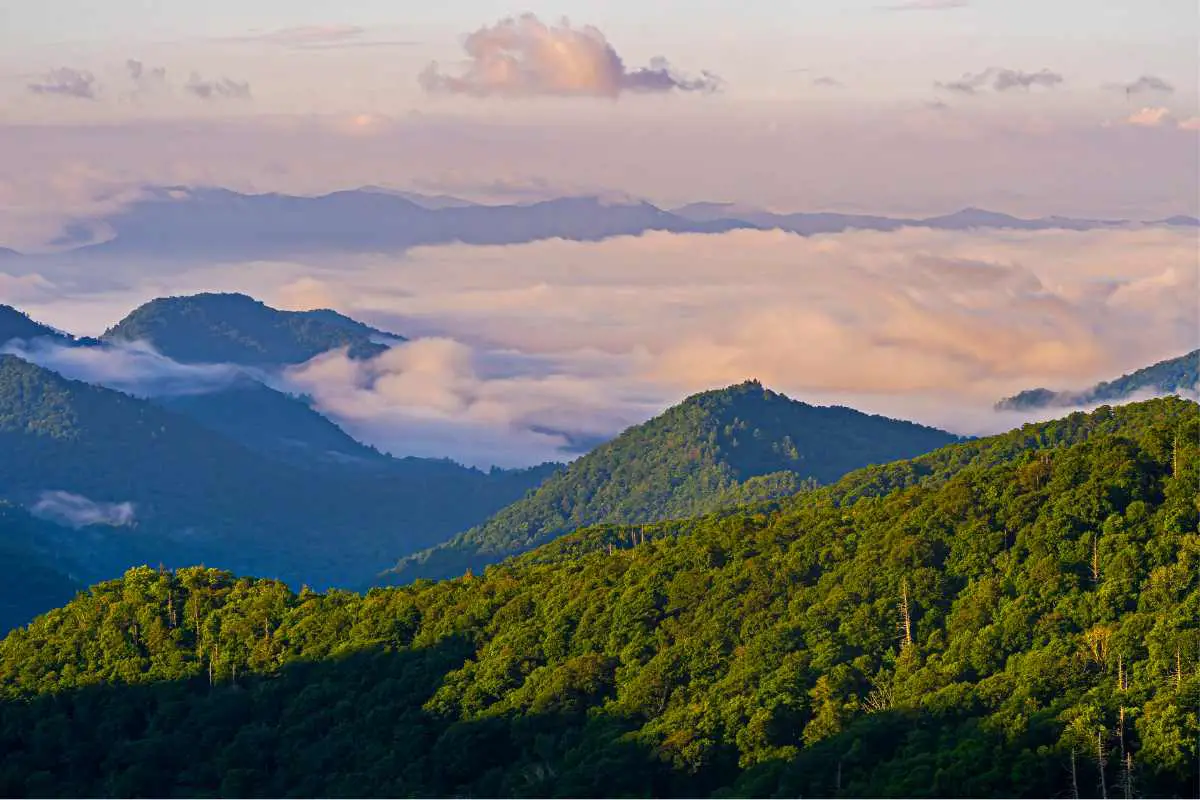The Great Smoky Mountains National Park is a hiker’s paradise with over 800 miles of trails to explore.
The park, which spans across Tennessee and North Carolina, offers a range of hiking experiences, from easy strolls to strenuous treks. Whether you’re a seasoned hiker or a beginner, there’s a trail for you in the Great Smoky Mountains.
With so many trails to choose from, it can be overwhelming to decide which ones to tackle. That’s why we’ve compiled a list of the best hiking trails in the Great Smoky Mountains.
Our list includes trails that offer stunning views, waterfalls, and old-growth forests. We’ve also included trails that are suitable for families and beginners, as well as more challenging hikes for experienced hikers.
So, grab your hiking boots and get ready to explore the beauty of the Great Smoky Mountains National Park.
Great Smoky Mountains National Park
Great Smoky Mountains National Park is a national park located in the United States, encompassing over 500,000 acres of land in the Appalachian Mountains of Tennessee and North Carolina.

It is renowned for its diverse flora and fauna, scenic beauty, and numerous hiking trails. The park is named for the “smoky” fog that often covers the mountains, created by the natural release of moisture from the dense forests.
The Great Smoky Mountains National Park is one of the most visited national parks in the United States, attracting millions of visitors every year.
The park offers a wide range of activities, including hiking, camping, fishing, horseback riding, and wildlife watching. With over 800 miles of hiking trails, the park is a hiker’s paradise, offering trails ranging from easy walks to strenuous hikes.
The park is home to a diverse range of wildlife, including black bears, elk, deer, and over 200 species of birds.
Visitors are advised to take precautions when hiking in bear country, including carrying bear spray and making noise to avoid surprising bears.
The Great Smoky Mountains National Park is also home to a rich cultural history, with many historic homes, churches, and other structures preserved within its boundaries. The park offers a glimpse into the lives of the people who once lived in the region, including the Cherokee Indians and early settlers.
Overall, the Great Smoky Mountains National Park is a must-visit destination for anyone who loves the outdoors, wildlife, and history.
With its stunning scenery, diverse wildlife, and numerous recreational opportunities, it is a true national treasure.
Best Time to Hike
The Great Smoky Mountains National Park is a hiking paradise that offers breathtaking views and diverse landscapes throughout the year.
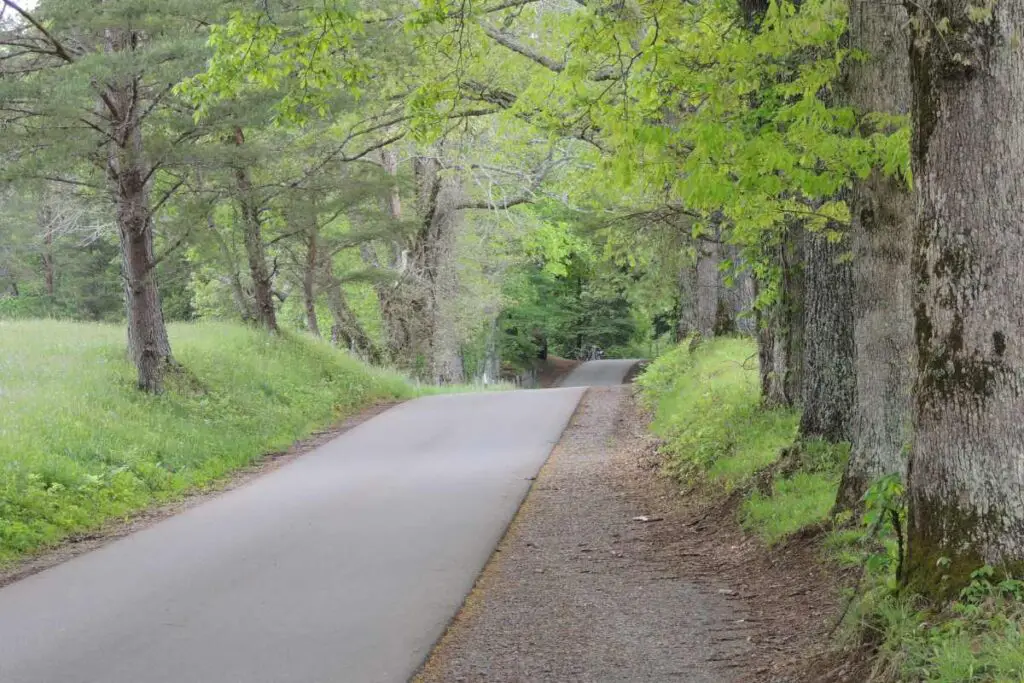
Each season has its unique charm, and the best time to hike depends on personal preferences and the type of experience you are looking for.
Spring
Spring is an excellent time to hike in the Great Smoky Mountains, with temperatures ranging from the mid-50s to the mid-70s.
The park’s wildflowers are in full bloom, and the waterfalls are at their peak flow. However, the downside of hiking in spring is the unpredictable weather, so be sure to check the forecast before heading out.
Summer
Summer is the busiest time of the year in the Great Smoky Mountains, with warm temperatures and long daylight hours.
The park’s lush vegetation is in full bloom, and the wildlife is active. However, the trails can be crowded, and the humidity can be oppressive, so be sure to bring plenty of water and sunscreen.
Autumn
Autumn is one of the most popular times to hike in the Great Smoky Mountains, with cool temperatures and stunning fall foliage.
The park’s hardwood forests turn into a kaleidoscope of colors, making it a photographer’s paradise. However, the trails can be crowded, especially during peak leaf-peeping season, so plan accordingly.
Winter
Winter is a quiet and peaceful time to hike in the Great Smoky Mountains, with fewer crowds and stunning winter landscapes.
The park’s waterfalls freeze into icicles, and the snow-covered mountains offer breathtaking views. However, the trails can be icy and treacherous, so be sure to wear proper footwear and check the trail conditions before heading out.
Overall, the best time to hike in the Great Smoky Mountains National Park depends on personal preferences and the type of experience you are looking for. Each season has its unique charm, and the park offers something for everyone.
Trail Classification

Great Smoky Mountains National Park has a variety of trails for hikers of all levels. The trails are classified based on their difficulty level, length, and elevation gain.
It’s important to choose a trail that suits your fitness level and experience. Here’s a breakdown of the trail classification in the park:
Easy Trails
Easy trails are suitable for beginners and families with children. These trails are well-maintained and have gentle slopes. They are usually less than 3 miles long and have minimal elevation gain.
Some of the popular easy trails in the park include:
- Laurel Falls Trail
- Little River Trail
- Oconaluftee River Trail
Moderate Trails
Moderate trails are suitable for hikers with some experience.
These trails have steeper slopes and may have some obstacles such as rocks and roots. They are usually between 3 to 6 miles long and have moderate elevation gain.
Some of the popular moderate trails in the park include:
- Alum Cave Trail
- Chimney Tops Trail
- Rainbow Falls Trail
Strenuous Trails
Strenuous trails are suitable for experienced hikers who are in good physical condition.
These trails have steep slopes and may require scrambling over rocks and boulders. They are usually longer than 6 miles and have significant elevation gain.
Some of the popular strenuous trails in the park include:
- Mount LeConte via Alum Cave Trail
- Ramsey Cascades Trail
- Charlies Bunion Trail
Backcountry Trails
Backcountry trails are suitable for backpackers who want to explore the wilderness of the park.
These trails are not maintained and may have obstacles such as fallen trees and stream crossings. Backpackers are required to obtain a permit before entering the backcountry.
Some of the popular backcountry trails in the park include:
- Appalachian Trail
- Hazel Creek Trail
- Forney Ridge Trail
In conclusion, Great Smoky Mountains National Park has a variety of trails for hikers of all levels.
It’s important to choose a trail that suits your fitness level and experience. Always carry enough water, food, and appropriate gear for the trail you plan to hike.
Top Hiking Trails

The Great Smoky Mountains National Park offers some of the best hiking trails in the country, with a variety of options for hikers of all skill levels.
Here are some of the top hiking trails to explore in the park.
Alum Cave Trail
The Alum Cave Trail is a popular 5.5-mile round trip hike that offers stunning views of the park. The trail starts at the Alum Cave Bluffs, which are a unique formation of orange clay and rock.
From there, hikers can continue on to the summit of Mount LeConte, which offers panoramic views of the surrounding area.
Andrews Bald
Andrews Bald is a 1.8-mile round trip hike that offers stunning views of the park’s high country.
The trail starts at the Clingmans Dome parking area and follows a paved path to the summit of Andrews Bald. From there, hikers can enjoy breathtaking views of the surrounding mountains and valleys.
Trillium Gap Trail
The Trillium Gap Trail is a 6.6-mile round trip hike that leads to the summit of Mount LeConte.
The trail starts at the Rainbow Falls trailhead and follows a scenic path through old-growth forests and past several waterfalls. The summit of Mount LeConte offers stunning views of the park and is a popular destination for hikers.
Chimney Tops Trail
The Chimney Tops Trail is a challenging 4-mile round trip hike that offers breathtaking views of the park.
The trail starts at the Chimney Tops picnic area and follows a steep path to the summit of Chimney Tops. From there, hikers can enjoy panoramic views of the surrounding mountains and valleys.
Rainbow Falls Trail
The Rainbow Falls Trail is a popular 5.4-mile round trip hike that leads to Rainbow Falls, one of the park’s most scenic waterfalls.
The trail starts at the Rainbow Falls trailhead and follows a scenic path through old-growth forests and past several smaller waterfalls before reaching Rainbow Falls.
Boulevard Trail
The Boulevard Trail is a challenging 15.7-mile round trip hike that offers stunning views of the park’s high country.
The trail starts at the Newfound Gap parking area and follows a scenic path through old-growth forests and past several waterfalls before reaching the summit of Mount LeConte.
Abrams Falls Trail
The Abrams Falls Trail is a popular 5.2-mile round trip hike that leads to Abrams Falls, one of the park’s most scenic waterfalls.
The trail starts at the Abrams Falls trailhead and follows a scenic path through old-growth forests and past several smaller waterfalls before reaching Abrams Falls.
Grotto Falls Trail
The Grotto Falls Trail is a popular 2.6-mile round trip hike that leads to Grotto Falls, one of the park’s most scenic waterfalls.
The trail starts at the Trillium Gap trailhead and follows a scenic path through old-growth forests and past several smaller waterfalls before reaching Grotto Falls.
Gatlinburg Trail
The Gatlinburg Trail is a popular 3.8-mile round trip hike that offers stunning views of the park.
The trail starts at the Sugarlands Visitor Center and follows a scenic path along the Little Pigeon River before reaching the town of Gatlinburg.
Oconaluftee River Trail
The Oconaluftee River Trail is a popular 1.5-mile round trip hike that follows the Oconaluftee River through the park.
The trail starts at the Oconaluftee Visitor Center and follows a scenic path through old-growth forests and past several historic buildings before reaching the river.
Whether you’re an experienced hiker or just starting out, the Great Smoky Mountains National Park has something for everyone. With its stunning views and diverse landscapes, it’s no wonder why this park is a favorite among hikers and outdoor enthusiasts.
Hiking Essentials
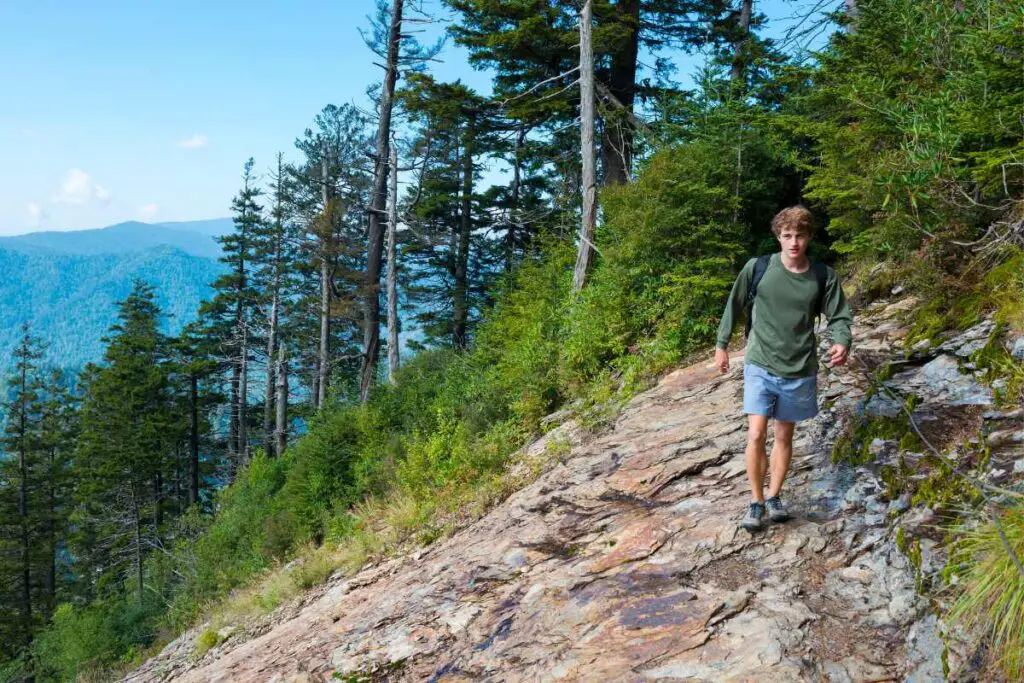
When preparing for a hiking trip in the Great Smoky Mountains, it’s important to have the right gear and equipment to ensure a safe and enjoyable experience.
Here are some essential items to consider:
Navigation
A map and compass are essential for any hiking trip in the Great Smoky Mountains. Make sure to bring a detailed map of the area and a compass to help you navigate the trails.
It’s also a good idea to bring a GPS device or a smartphone with a GPS app in case you need to track your location.
Sun Protection
The sun can be intense in the mountains, so it’s important to protect your skin and eyes.
Bring sunscreen with an SPF of at least 30 and wear a hat and sunglasses to shield your face and eyes from the sun.
👒 Read next 🤠 Best hiking hats for men and hats for women.
Insulation
Temperatures can vary greatly in the Great Smoky Mountains, so it’s important to bring appropriate clothing to stay warm and dry. Dress in layers and bring a waterproof jacket in case of rain.
Illumination
A headlamp or flashlight is essential for any hiking trip, especially if you plan to hike at night. Make sure to bring extra batteries and keep your light source easily accessible.
First-Aid Supplies
Accidents can happen on the trail, so it’s important to bring a basic first-aid kit with you. Include items such as bandages, gauze, antiseptic wipes, and pain relievers.
Fire Starter
In case of emergency, it’s important to have a way to start a fire. Bring waterproof matches or a lighter, and consider bringing a fire starter kit as a backup.
Repair Kit and Tools
Bring a small repair kit with items such as duct tape, a multi-tool, and a sewing kit. These items can come in handy if you need to make quick repairs to your gear.
Nutrition and Hydration
Bring plenty of water and snacks to keep you fueled and hydrated on the trail. Consider bringing a water filter or purification tablets if you plan to refill your water bottles from natural sources.
Emergency Shelter
In case of unexpected weather or an emergency, it’s important to have a way to stay warm and dry. Bring a lightweight emergency shelter such as a bivy sack or a space blanket.
Remember to also check for any necessary permits or parking tags, and make sure to bring your vehicle and license plate number with you.
For those planning to backpack or camp in the backcountry, make sure to obtain the necessary permits beforehand.
Safety and Regulations
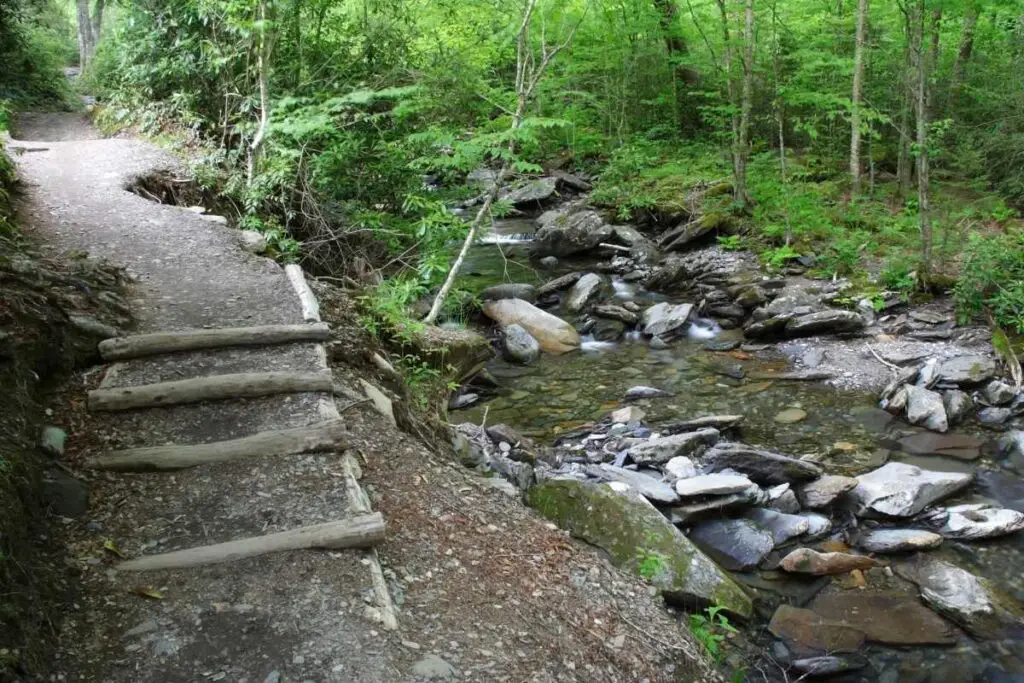
Hiking in Great Smoky Mountains National Park can be a thrilling and rewarding experience, but it’s important to take the necessary precautions to ensure your safety.
Here are some safety tips and regulations to keep in mind:
- Carry a small first aid kit and know how to use it. In case of an emergency, call 911 or seek help from a park ranger.
- Check the current weather forecast and be prepared for quickly changing conditions. Wear shoes or boots that provide good ankle support and avoid cotton clothing. Dress in layers that can be easily removed or added as you heat up or cool down.
- Stay on designated trails and follow all posted signs and regulations. Do not disturb wildlife or their habitats, and keep a safe distance from any animals you encounter. Feeding or approaching wildlife is strictly prohibited.
- If you plan on hiking with your dog, make sure to keep them on a leash at all times and clean up after them. Dogs are not allowed on trails that are not designated as pet-friendly, and they are not allowed in park buildings or on shuttle buses.
- Be aware of the potential for encounters with black bears and other wildlife. Carry bear spray and know how to use it. If you encounter a bear, do not run. Instead, speak calmly and firmly, and slowly back away. Do not approach the bear or attempt to take photos.
- Leave no trace. Pack out all trash and dispose of it properly. Do not disturb or remove any natural or cultural features, such as plants, rocks, or artifacts.
Read next – Best Hiking Dogs
By following these safety tips and regulations, you can help ensure a safe and enjoyable hiking experience in Great Smoky Mountains National Park.
Accommodations

When planning a hiking trip to the Great Smoky Mountains, finding suitable accommodations is crucial. Luckily, there are plenty of options available, ranging from luxurious hotels to rustic cabins and campgrounds.
Lodging
For those who prefer the comfort of a hotel, there are several options to choose from. Dancing Bear Lodge, located in Townsend, TN, is a highly rated hotel that offers free Wi-Fi and a 3.5-star hotel class.
Another popular option is Snowbird Mountain Lodge, an all-inclusive luxury hotel that features indulgent cabins and rooms with in-room fireplaces and spa baths made for two.
LeConte Lodge
If you’re looking for a unique lodging experience, consider staying at LeConte Lodge. This rustic lodge is only accessible by foot and offers stunning views of the surrounding mountains.
The lodge provides basic amenities such as bunk beds, meals, and hot showers, making it a great option for those who want to disconnect from the outside world and immerse themselves in nature.
Camping
For the adventurous types, camping is a great way to experience the beauty of the Great Smoky Mountains up close.
The park has ten developed campgrounds that offer a range of amenities, from flush toilets and showers to fire rings and picnic tables. Some popular campgrounds include Elkmont Campground, Cades Cove Campground, and Smokemont Campground.
No matter what type of accommodations you choose, be sure to book in advance, especially during peak season. And remember to always follow Leave No Trace principles to help preserve the natural beauty of the Great Smoky Mountains for generations to come.
Visitor Centers
When visiting the Great Smoky Mountains National Park, it’s always a good idea to start your trip at one of the park’s visitor centers.
These centers provide helpful information about the park, its trails, and the wildlife that call it home.
One of the most popular visitor centers is the Sugarlands Visitor Center, located inside the park, 2 miles south of Gatlinburg on US-441.
Here, you can watch a free 20-minute film about the park and walk through an extensive natural history exhibit that features native plant and wildlife species. The center is open every day except Christmas Day at 8 a.m.
Another visitor center worth visiting is the Oconaluftee Visitor Center, which is located on the North Carolina side of the park near Cherokee. This center offers similar exhibits and information as the Sugarlands Visitor Center and is open year-round.
At both of these visitor centers, you can speak with park rangers who can provide valuable information about the park’s trails, wildlife, and history. You can also pick up maps and guidebooks to help plan your hikes and other activities in the park.
Overall, the Great Smoky Mountains National Park’s visitor centers are a great resource for anyone planning a trip to the park. Whether you’re a seasoned hiker or a first-time visitor, the knowledgeable staff at these centers can help you make the most of your time in the park.
Mountain Peaks and Vistas
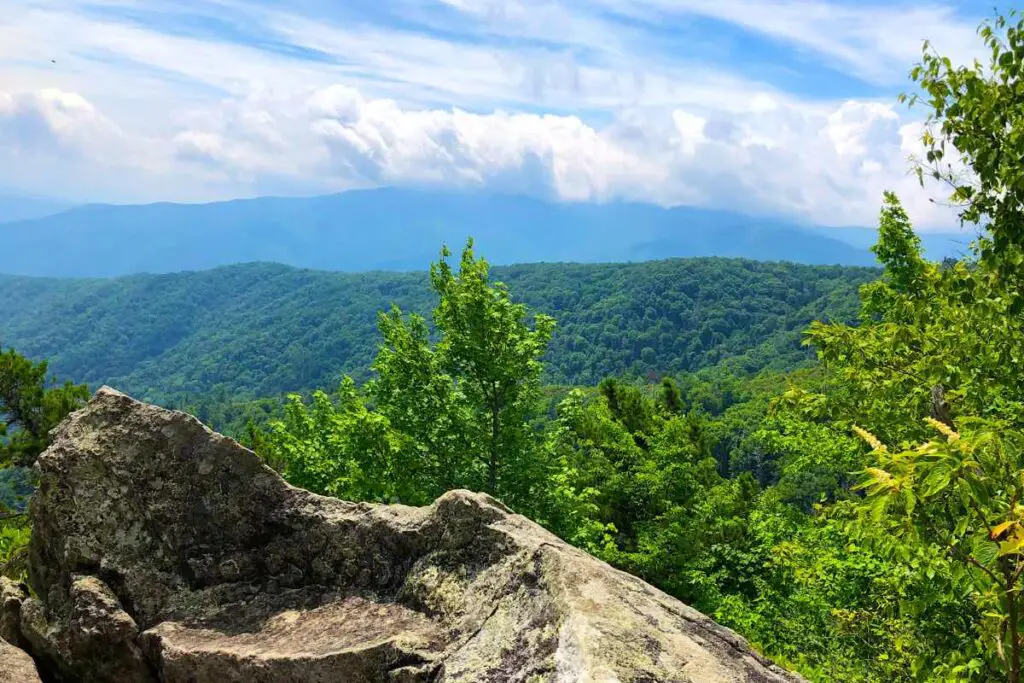
The Great Smoky Mountains National Park is home to some of the most stunning mountain peaks and vistas in the world.
From the top of Mount LeConte to the Clingmans Dome summit, visitors can experience breathtaking views of the surrounding landscape.
One of the most popular hikes in the park is the Alum Cave Trail to Mount LeConte. This 11-mile round trip hike offers incredible views of the surrounding mountains and valleys. Along the way, hikers will pass by landmarks such as Arch Rock and Alum Cave Bluffs.
For those looking for a more challenging hike, Mount Cammerer is a great option. The 11-mile round trip hike to the summit offers stunning views of the surrounding mountains and valleys. The summit itself is home to a historic fire lookout tower that offers 360-degree views of the surrounding landscape.
Another great hike for experienced hikers is the Mount Sterling via Baxter Creek Trail. This strenuous 11.7-mile round trip hike offers stunning views of the surrounding mountains and valleys. Hikers will climb over 5,842 feet to reach the summit of this North Carolina mountain.
Visitors to the park can also experience stunning vistas from the Clingmans Dome summit. This observation tower offers 360-degree views of the surrounding landscape, including views of both Tennessee and North Carolina.
Overall, the Great Smoky Mountains National Park offers some of the most stunning mountain peaks and vistas in the world. Whether you’re an experienced hiker or just looking for a leisurely hike, there’s something for everyone in this beautiful park.
Flora and Fauna

Great Smoky Mountains National Park is home to an incredible variety of flora and fauna.
The park is one of the most biodiverse regions in the world, with over 17,000 species documented.
Here are some of the highlights:
Wildflowers
The park is known for its stunning wildflowers, which bloom from early spring through late fall. Over 1,500 species of flowering plants have been identified in the park, including 100 species of native orchids.
Some of the most popular wildflowers include trillium, lady’s slipper, and violets. Visitors can enjoy wildflower walks and guided hikes throughout the park.
Old-growth Forest
The park is also home to some of the last remaining old-growth forests in the eastern United States.
These forests are characterized by large, mature trees and a diverse understory of shrubs, ferns, and wildflowers. The park’s old-growth forests provide critical habitat for a variety of wildlife, including black bears, deer, and songbirds.
Stay safe 🦌 What to Do if You See a Deer While Hiking?
Wildlife
The park is home to a wide variety of wildlife, including 65 species of mammals, over 200 species of birds, and 67 species of fish.
Visitors may see black bears, elk, deer, coyotes, and bobcats, as well as numerous bird species such as warblers, vireos, and woodpeckers. The park’s rivers and streams are home to a variety of fish, including trout and bass.
Conservation
The park is committed to preserving its unique flora and fauna for future generations.
The park’s rangers and staff work tirelessly to protect the park’s biodiversity through a variety of conservation efforts, including invasive species management, habitat restoration, and wildlife monitoring.
Visitors can support these efforts by following park regulations and practicing Leave No Trace principles while hiking and camping in the park.
Local Attractions

In addition to the beautiful hiking trails, the Great Smoky Mountains area offers many other attractions worth exploring.
Here are a few highlights:
Gatlinburg
Gatlinburg is a charming town located just outside the national park’s entrance. It offers a variety of shops, restaurants, and attractions, including the Gatlinburg SkyBridge, which is the longest pedestrian suspension bridge in North America.
Visitors can also check out the Gatlinburg Space Needle, which offers stunning views of the surrounding area from its observation deck.
Cades Cove
Cades Cove is a beautiful valley located in the Tennessee section of the park. It offers a scenic 11-mile loop road that visitors can drive or bike, as well as several hiking trails.
The area is also home to several historic buildings, including a grist mill and a church, which provide a glimpse into the region’s past.
Clingmans Dome
Clingmans Dome is the highest point in the park, offering stunning panoramic views of the surrounding mountains.
Visitors can hike the half-mile trail to the observation tower at the summit, which provides an even better view. The area is also home to several other hiking trails, including the challenging 8.2-mile roundtrip hike to Charlies Bunion.
North Carolina
The North Carolina section of the park offers several beautiful hiking trails, including the strenuous 11.7-mile roundtrip hike to Mt. Sterling via the Baxter Creek Trail.
Visitors can also explore the historic Oconaluftee area, which features several restored buildings and a museum.
Tennessee
The Tennessee section of the park is home to several beautiful waterfalls, including the popular Rainbow Falls and Grotto Falls. Visitors can also explore the historic Elkmont area, which features several preserved buildings from the early 1900s.
Overall, the Great Smoky Mountains area offers a wide variety of attractions for visitors to enjoy in addition to the many hiking trails.
Whether you’re interested in history, stunning views, or just a fun day out, there’s something for everyone to enjoy in this beautiful region.
Frequently Asked Questions

What are some family-friendly hiking trails in the Smoky Mountains?
The Smoky Mountains offer several family-friendly hiking trails that are suitable for children and beginners. Some of the popular family-friendly hiking trails include Laurel Falls Trail, Grotto Falls Trail, and the Oconaluftee River Trail. These trails are relatively easy and offer beautiful scenery.
Which hikes in the Smoky Mountains offer the best views?
The Smoky Mountains are known for their stunning views. Some of the hikes that offer the best views include Clingmans Dome, Chimney Tops Trail, and Alum Cave Trail. These trails are moderate to strenuous and offer breathtaking views of the mountains and valleys.
What is the Chimney Tops Trail and is it worth hiking?
The Chimney Tops Trail is a popular hiking trail in the Smoky Mountains. The trail is a strenuous 4-mile round trip hike that offers stunning views of the mountains. The trail is worth hiking, but it is important to note that it can be challenging, and hikers should be prepared for steep inclines and rocky terrain.
What are the top 3 day hikes in the Smoky Mountains?
The Smoky Mountains offer several day hikes that are worth exploring. The top 3 day hikes include Mount LeConte via Alum Cave Trail, Charlies Bunion via Appalachian Trail, and Andrews Bald via Forney Ridge Trail. These trails offer stunning views and are moderate to strenuous.
What are the easiest and most difficult hiking trails in the Smoky Mountains?
The Smoky Mountains offer hiking trails for hikers of all skill levels. Some of the easiest hiking trails include Gatlinburg Trail, Oconaluftee River Trail, and Cades Cove Nature Trail. The most difficult hiking trails include Mount LeConte via Alum Cave Trail, Chimney Tops Trail, and Ramsey Cascades Trail.
Which is the most popular hiking trail in the Great Smoky Mountains National Park?
The most popular hiking trail in the Great Smoky Mountains National Park is the Alum Cave Trail. The trail offers stunning views and is a moderate to strenuous hike. It is important to note that the trail can be crowded during peak season, and hikers should plan accordingly.
